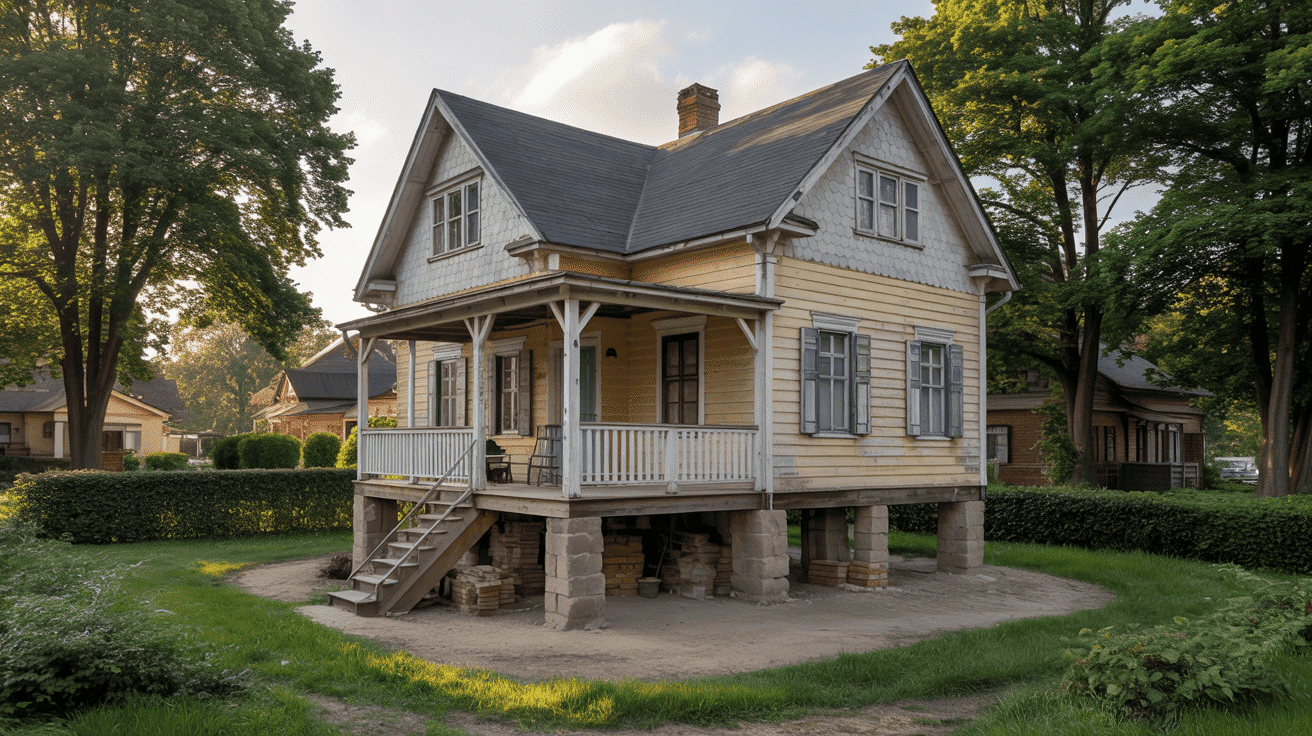Have you ever wondered why some homes stay dry and damage-free while others constantly battle moisture problems and costly repairs?
What if I told you there’s a foundation type that could have prevented this nightmare entirely?
Raised foundations aren’t just trendy architectural choices; they’re smart solutions that protect your home from moisture, pests, and costly repairs.
I’ve seen countless homeowners wish they’d known about crawl space, pier, and beam, and raised slab options before building. These foundations offer superior protection, easier utility access, and better ventilation than traditional slabs.
In this guide, I’ll walk you through everything you need to know about raised foundations, helping you make an informed decision that could save your home and your wallet from future headaches.
Raised Foundations: Your Shield Against Water Damage
Raised foundations are construction systems that lift your home several feet above ground level. Unlike regular foundations that sit on or below ground, these create an intentional gap between your house and the earth.
These systems work by using vertical supports, such as concrete columns, steel posts, or masonry walls, to carry the weight of your home. This creates an open or enclosed space underneath your living area.
The main difference from standard foundations is the approach to ground contact. Regular foundations work with existing ground conditions. Raised systems separate your structure from potential ground problems entirely.
This separation gives you practical benefits. You get protection from ground moisture that causes rot and mold. The space underneath provides room for plumbing and electrical systems. Better air circulation helps control temperature and prevents humidity buildup.
Raised foundations also solve building challenges other foundation types cannot handle. They work on sites with poor drainage, unstable soil, or steep slopes. This makes them valuable for difficult locations where other options might fail or cost too much to prepare.
Types of Raised Foundations
Each raised foundation type offers different benefits for cost, accessibility, and performance based on your specific property needs.
1. Crawl Space Foundations
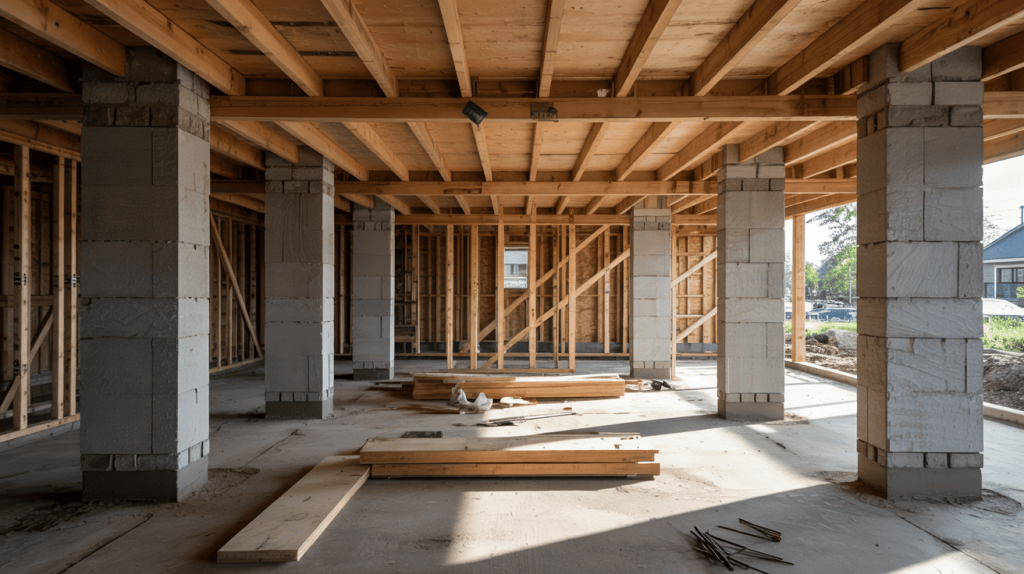
Crawl space foundations create a short, enclosed area beneath your home, typically 1.5 to 4 feet high. This type uses concrete or block walls around the perimeter, with the floor joists spanning across the space. They’re commonly used in moderate climates where frost protection is needed, but full basements aren’t necessary.
- Key Benefits: The main advantages include better insulation than pier systems. They offer a cost-effective solution for homes on stable, flat lots in moderate climate zones.
- Potential Drawbacks: However, they can develop humidity issues without proper ventilation, and the limited height restricts maintenance access. This foundation type isn’t ideal for sloped terrain or areas with significant soil movement.
2. Pier and Beam Foundations
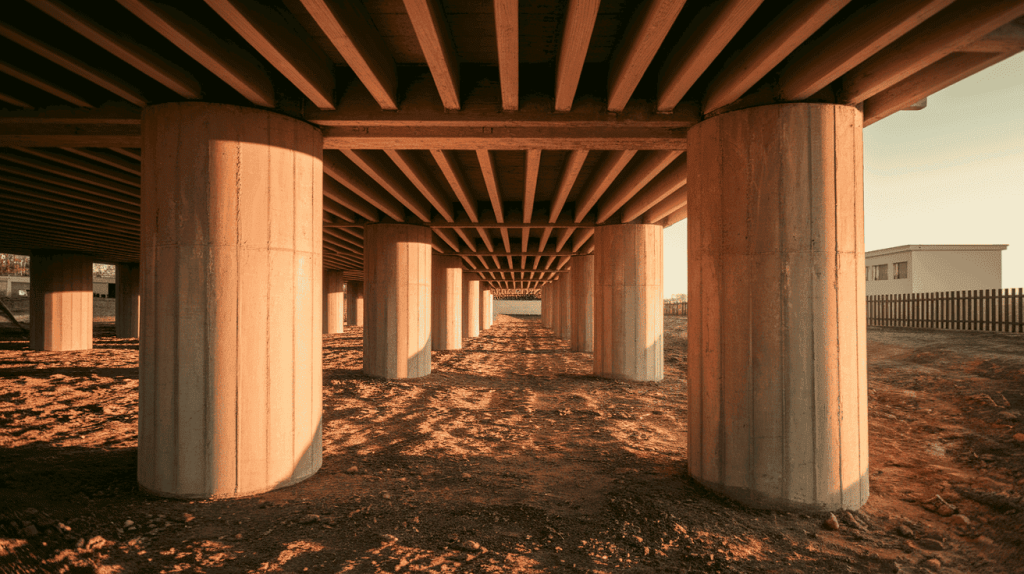
Pier and beam systems use individual concrete or wooden posts to support horizontal beams that carry your home’s weight. Unlike crawl spaces, this design creates completely open space underneath your house. The piers are spaced at regular intervals, typically 6 to 8 feet apart, with beams connecting them.
- Why Choose Pier and Beam: This type offers outstanding ventilation with free airflow and easy access for repairs and utility work. It adapts perfectly to sloped or uneven terrain and remains adjustable if settling occurs over time, making it ideal for areas with expansive clay soils.
- Cost and Versatility: Pier and beam systems are typically the most budget-friendly raised foundation option. They work well in all climate conditions and provide the flexibility homeowners need for future modifications or repairs.
3. Raised Slab Foundations
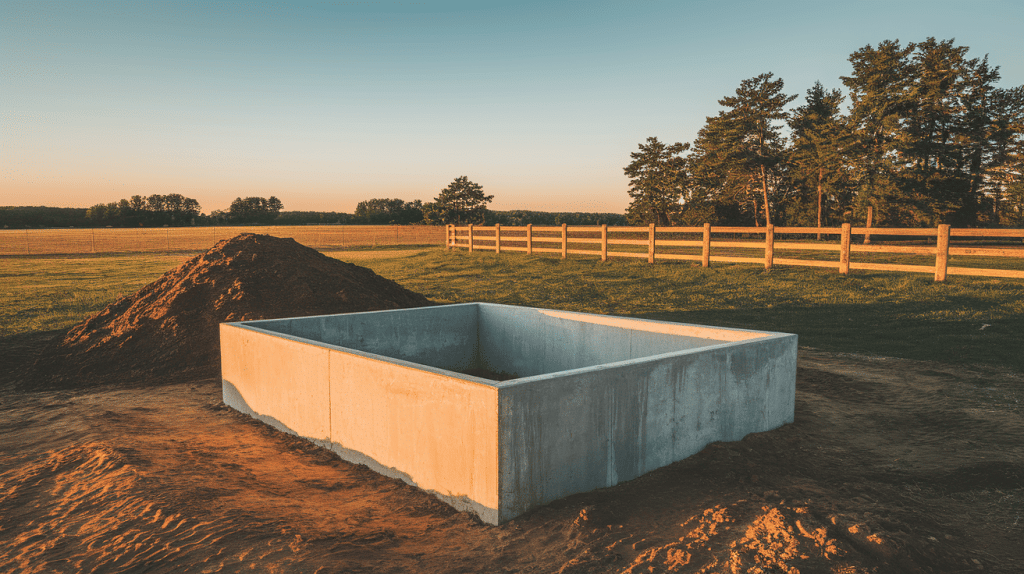
Raised slab foundations combine the benefits of traditional slabs with elevation above ground level. The concrete slab is poured on a stem wall or elevated platform, creating air space underneath. This hybrid approach provides the structural strength of concrete with the moisture protection of raised systems.
- Maximum Durability: The main benefit is exceptional longevity with a 50+ year lifespan and superior pest resistance from concrete construction. They provide excellent structural stability, making them perfect for high-wind areas and seismic zones with minimal long-term maintenance requirements.
- Important Considerations: However, they involve higher upfront construction costs and make utility access difficult once built. This foundation type works best for flat to moderately sloped lots where maximum durability is the priority.
Comparison of Raised Foundation Types
| Feature | Crawl Space | Pier and Beam | Raised Slab |
|---|---|---|---|
| Construction Cost | Moderate | Lower | Higher |
| Access for Repairs | Limited | Excellent | Difficult |
| Durability | 30-50 years | 20-40 years | 50+ years |
| Best for Terrain | Flat lots | Sloped/uneven | Flat to moderate |
| Moisture Control | Good | Excellent | Good |
| Pest Resistance | Good | Good | Excellent |
| Maintenance Needs | Regular checks | Periodic inspection | Minimal |
| Adjustability | Limited | High | None |
| Ventilation | Good with vents | Excellent | Limited |
| Installation Speed | Moderate | Fast | Slow |
| Energy Efficiency | Good insulation | Moderate | Built-in thermal mass |
| Structural Stability | Good | Moderate | Excellent |
Best Choice For:
- Crawl Space: Budget-conscious builds on level ground with moderate climate
- Pier and Beam: Sloped properties, soil movement areas, or easy utility access needs
- Raised Slab: Maximum durability in high-wind, seismic, or extreme weather zones
Key Benefits of Raised Foundations
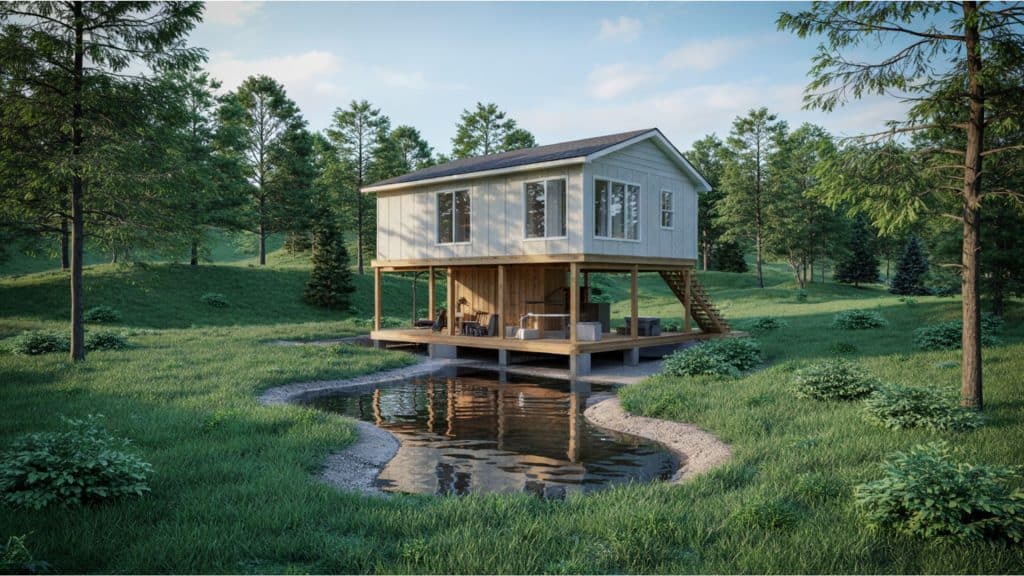
1. Flood Protection: Raised foundations lift your home above potential flood levels, providing crucial protection during heavy rains and seasonal flooding. This height advantage can save thousands of dollars in water damage repairs.
2. Moisture Control: The separation between your home and the ground prevents water damage and mold growth. Ground moisture stays where it belongs, away from your home’s framework and living spaces.
3. Pest Prevention: Creating a gap underneath your home makes it much harder for termites and rodents to access your structure. You can easily spot and treat pest problems before they become major headaches.
4. Utility Access: Need to fix plumbing or electrical issues? Raised foundations make maintenance simple with accessible space for all your home systems. This means faster repairs and lower costs.
5. Natural Ventilation: Air flows freely beneath your home, helping regulate temperature and humidity. This natural cooling effect reduces energy bills and prevents structural damage from trapped moisture.
6. Terrain Flexibility: Building on a slope? No problem. These foundations adapt to uneven ground without expensive grading, working with your property’s natural landscape instead of fighting it.
How to Choose the Right Raised Foundation?
Selecting the perfect raised foundation requires evaluating your property’s characteristics and balancing site requirements with budget and long-term goals.
Assessing Site Conditions:
Evaluate your soil type – Clay soils require pier and beam systems, while stable soils support various foundation types.
Consider your lot’s slope, as steep terrain favors pier and beam foundations while gentler slopes work with crawl spaces or raised slabs. Examine flood risk, as homes in flood zones benefit most from higher elevations.
Budget Considerations:
Balance upfront costs with long-term benefits. Pier and beam systems cost less initially but need more maintenance, while crawl spaces offer moderate pricing with good performance.
Raised slabs cost more upfront but provide maximum durability and potential savings from flood protection.
Consulting Professionals:
Structural engineers assess soil conditions and recommend suitable options, while local contractors understand regional codes and climate considerations.
Multiple professional opinions ensure you choose a foundation that meets immediate needs and provides lasting value.
Cost of Raised Foundations
Raised foundations require more money upfront than regular slabs. However, they save you money over time through protection and lower maintenance costs.
Several factors determine how much you’ll pay for a raised foundation. Location matters because labor costs and materials vary by region, while local building codes also impact pricing.
Materials make a difference in your budget – concrete and steel cost more than wood but last longer. Simple designs cost less than complex ones, so the foundation type you choose directly affects your final price.
Price Ranges by Type
Here’s what you can expect to pay per square foot:
- Pier and beam: $7-12 (cheapest option)
- Crawl space: $10-16 (middle range)
- Raised slab: $12-20 (most expensive)
Bottom line: You pay more now but save more later. The protection and easier maintenance make raised foundations a smart investment for most homes.
Challenges and Limitations of Raised Foundations
While raised foundations offer many advantages, they come with some trade-offs you should consider. Understanding these limitations helps you make an informed decision about whether this foundation type fits your needs and budget.
-
Raised foundations typically have higher initial costs due to additional materials and labor.
-
Regular inspections are needed for moisture buildup, pests, and structural integrity, with ongoing maintenance for ventilation and drainage.
-
Crawl spaces and pier and beam foundations offer limited headroom, restricting storage space and access.
-
Open space under the home can be affected by weather conditions, potentially causing temperature fluctuations inside the house.
-
Confined spaces may make some repairs difficult, requiring professional help for certain tasks.
-
Raised foundations, particularly pier and beam types, may settle over time and require adjustments.
-
In areas with extremely high water tables, raised foundations may still be vulnerable to flooding if not properly sealed.
-
Extremely steep or uneven ground may require modifications or make some raised foundation types less feasible.
Conclusion
Raised foundations offer a smart solution for homeowners seeking long-term protection and value. From flood prevention to pest control, these high systems provide benefits that far outweigh their initial investment.
The three main types are crawl space, pier and beam, and raised slab – each serves different needs and budgets, ensuring there’s an option for every property.
By carefully evaluating your site conditions, budget, and long-term goals, you can select the foundation type that best serves your home. Remember that professional consultation is key to making the right choice for your specific situation.
Ready to protect your home with a raised foundation? Start by consulting with local structural engineers and contractors who can assess your property and provide personalized recommendations that fit your needs and budget.

